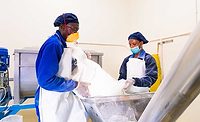Study Characterizes Dry Salmonella Biofilms, Offers Sanitization Strategy for Low-Moisture Food Industry

Image credit: Freepik
Pathogen biofilm formation is a significant challenge for food safety. Most existing research on biofilms affecting the food industry has focused on wet surface biofilms as they have historically been believed to be a greater risk than biofilms in dry conditions; however, recent foodborne illness outbreaks and recalls associated with low-moisture foods (LMFs) have suggested the need to examine and address biofilms in dry conditions.
To fill the knowledge gap around dry surface biofilms (DSBs), researchers from the National University of Singapore conducted a study to provide detailed characterization of Salmonella DSBs, including their morphology, single-cell landscape, and response to sanitization techniques in comparison to traditional WSBs. Led by Dan Li, Ph.D., Assistant Professor in the NUS Department of Food Science and Technology, researchers examined Salmonella Typhimurium DSBs using advanced microscopy techniques, such as confocal laser scanning, transmission electron, and scanning electron microscopy.
The researchers discovered features unique to DSBs that are not seen in WSBs. Specifically, DSB cells are surrounded by a dense, compact shell that likely contributes to their higher antimicrobial resistance (AMR), while WSB cells display distinct plasma and outer membrane layers. Additionally, DSBs exhibit a “sandwich-like” vertical structure, with intact cells at the core and damaged cells on the outer layer. Using single-cell transcriptomics, the researchers also identified bacterial clusters within the biofilm with active antioxidative and virulence functions, raising food safety concerns for LMFs.
Based on their findings, Dr. Li’s team developed a waterless antibiofilm sanitization protocol specifically designed for low-moisture food production environments, which combines flavonoid morin with 70 percent isopropyl alcohol. Dr. Li upholds flavonoid-based sanitizers as effective, environmentally friendly, and scalable solutions for biofilm management.
Looking for a reprint of this article?
From high-res PDFs to custom plaques, order your copy today!







